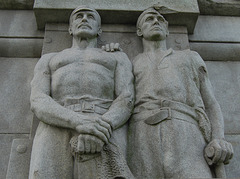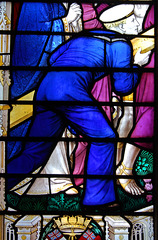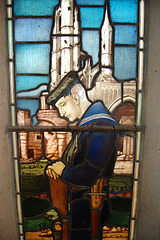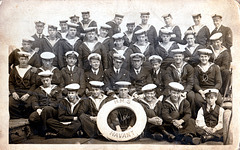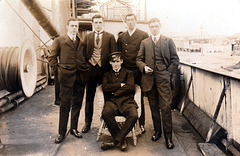
Sea Dogs
Folder: Past Lives
Detail of The Heroes of the Marine Engine Room, Pi…
| |
|
This is its listing description
Monument. 1916. By Sir William Goscombe John, originally designed to commemorate the engineers of the SS Titanic. Banded granite obelisk, 14.5 metres high rising from a pedestal set on a tall square chamfered plinth. On the east and west faces of the pedestal are carved life-size figures of the Engine Room Heroes'- stokers on the east face and engineers on the west. On the corners at the foot of the obelisk, at a level above the heads of the figures are carved representations of Water (north-west), Earth (north-east), Fire (south-east), and Air (south-west). Between these, stylised waves in low relief, from which, on each face, a rising sun emerges. At the top of the obelisk, on each face, a draped female form, depicting the sea. The figures grasp between them breech buoys, and thus form an encircling group of figures set beneath the gilded torch flame which crowns the monument. An inscription on the south face of the pedestal reads THE BRAVE DO NOT DIE/ THEIR DEEDS LIVE ON FOR EVER/ AND CALL UPON US/ TO EMULATE THEIR COURAGE/AND DEVOTION TO DUTY' On the north face, the inscription reads ALL HEROES OF THE / MARINE ENGINE ROOM/ THIS MEMORIAL/ WAS ERECTED BY/ INTERNATIONAL SUBSCRIPTION/ MCMXVI'. HISTORY: The memorial was originally intended to commemorate the 32 engineers of the Titanic' who remained at their posts to allow the greatest number of passengers to escape from the sinking liner. However, spaces were to be left to record other heroic deeds done by sea-going engineers'. However, because of the very high loss of life at sea during the progress of the First World War, it was thought appropriate to dedicate the monument to all maritime engine room fatalities. The memorial had a considerable influence upon the design of post -1919 war memorials, particularly in respect of the portrayal of the ordinary' man or woman, rather than of members of social or military elites. It is thought to be one of the most artistically- significant memorials to the Titanic' disaster on either side of the Atlantic.
Detail of The Heroes of the Marine Engine Room, Pi…
| |
|
|
This is its listing description
Monument. 1916. By Sir William Goscombe John, originally designed to commemorate the engineers of the SS Titanic. Banded granite obelisk, 14.5 metres high rising from a pedestal set on a tall square chamfered plinth. On the east and west faces of the pedestal are carved life-size figures of the Engine Room Heroes'- stokers on the east face and engineers on the west. On the corners at the foot of the obelisk, at a level above the heads of the figures are carved representations of Water (north-west), Earth (north-east), Fire (south-east), and Air (south-west). Between these, stylised waves in low relief, from which, on each face, a rising sun emerges. At the top of the obelisk, on each face, a draped female form, depicting the sea. The figures grasp between them breech buoys, and thus form an encircling group of figures set beneath the gilded torch flame which crowns the monument. An inscription on the south face of the pedestal reads THE BRAVE DO NOT DIE/ THEIR DEEDS LIVE ON FOR EVER/ AND CALL UPON US/ TO EMULATE THEIR COURAGE/AND DEVOTION TO DUTY' On the north face, the inscription reads ALL HEROES OF THE / MARINE ENGINE ROOM/ THIS MEMORIAL/ WAS ERECTED BY/ INTERNATIONAL SUBSCRIPTION/ MCMXVI'. HISTORY: The memorial was originally intended to commemorate the 32 engineers of the Titanic' who remained at their posts to allow the greatest number of passengers to escape from the sinking liner. However, spaces were to be left to record other heroic deeds done by sea-going engineers'. However, because of the very high loss of life at sea during the progress of the First World War, it was thought appropriate to dedicate the monument to all maritime engine room fatalities. The memorial had a considerable influence upon the design of post -1919 war memorials, particularly in respect of the portrayal of the ordinary' man or woman, rather than of members of social or military elites. It is thought to be one of the most artistically- significant memorials to the Titanic' disaster on either side of the Atlantic.
Detail of The Heroes of the Marine Engine Room, Pi…
| |
|
This is its listing description
Monument. 1916. By Sir William Goscombe John, originally designed to commemorate the engineers of the SS Titanic. Banded granite obelisk, 14.5 metres high rising from a pedestal set on a tall square chamfered plinth. On the east and west faces of the pedestal are carved life-size figures of the Engine Room Heroes'- stokers on the east face and engineers on the west. On the corners at the foot of the obelisk, at a level above the heads of the figures are carved representations of Water (north-west), Earth (north-east), Fire (south-east), and Air (south-west). Between these, stylised waves in low relief, from which, on each face, a rising sun emerges. At the top of the obelisk, on each face, a draped female form, depicting the sea. The figures grasp between them breech buoys, and thus form an encircling group of figures set beneath the gilded torch flame which crowns the monument. An inscription on the south face of the pedestal reads THE BRAVE DO NOT DIE/ THEIR DEEDS LIVE ON FOR EVER/ AND CALL UPON US/ TO EMULATE THEIR COURAGE/AND DEVOTION TO DUTY' On the north face, the inscription reads ALL HEROES OF THE / MARINE ENGINE ROOM/ THIS MEMORIAL/ WAS ERECTED BY/ INTERNATIONAL SUBSCRIPTION/ MCMXVI'. HISTORY: The memorial was originally intended to commemorate the 32 engineers of the Titanic' who remained at their posts to allow the greatest number of passengers to escape from the sinking liner. However, spaces were to be left to record other heroic deeds done by sea-going engineers'. However, because of the very high loss of life at sea during the progress of the First World War, it was thought appropriate to dedicate the monument to all maritime engine room fatalities. The memorial had a considerable influence upon the design of post -1919 war memorials, particularly in respect of the portrayal of the ordinary' man or woman, rather than of members of social or military elites. It is thought to be one of the most artistically- significant memorials to the Titanic' disaster on either side of the Atlantic.
Detail of The Heroes of the Marine Engine Room, Pi…
| |
|
This is its listing description
Monument. 1916. By Sir William Goscombe John, originally designed to commemorate the engineers of the SS Titanic. Banded granite obelisk, 14.5 metres high rising from a pedestal set on a tall square chamfered plinth. On the east and west faces of the pedestal are carved life-size figures of the Engine Room Heroes'- stokers on the east face and engineers on the west. On the corners at the foot of the obelisk, at a level above the heads of the figures are carved representations of Water (north-west), Earth (north-east), Fire (south-east), and Air (south-west). Between these, stylised waves in low relief, from which, on each face, a rising sun emerges. At the top of the obelisk, on each face, a draped female form, depicting the sea. The figures grasp between them breech buoys, and thus form an encircling group of figures set beneath the gilded torch flame which crowns the monument. An inscription on the south face of the pedestal reads THE BRAVE DO NOT DIE/ THEIR DEEDS LIVE ON FOR EVER/ AND CALL UPON US/ TO EMULATE THEIR COURAGE/AND DEVOTION TO DUTY' On the north face, the inscription reads ALL HEROES OF THE / MARINE ENGINE ROOM/ THIS MEMORIAL/ WAS ERECTED BY/ INTERNATIONAL SUBSCRIPTION/ MCMXVI'. HISTORY: The memorial was originally intended to commemorate the 32 engineers of the Titanic' who remained at their posts to allow the greatest number of passengers to escape from the sinking liner. However, spaces were to be left to record other heroic deeds done by sea-going engineers'. However, because of the very high loss of life at sea during the progress of the First World War, it was thought appropriate to dedicate the monument to all maritime engine room fatalities. The memorial had a considerable influence upon the design of post -1919 war memorials, particularly in respect of the portrayal of the ordinary' man or woman, rather than of members of social or military elites. It is thought to be one of the most artistically- significant memorials to the Titanic' disaster on either side of the Atlantic.
Detail of The Heroes of the Marine Engine Room, Pi…
| |
|
This is its listing description
Monument. 1916. By Sir William Goscombe John, originally designed to commemorate the engineers of the SS Titanic. Banded granite obelisk, 14.5 metres high rising from a pedestal set on a tall square chamfered plinth. On the east and west faces of the pedestal are carved life-size figures of the Engine Room Heroes'- stokers on the east face and engineers on the west. On the corners at the foot of the obelisk, at a level above the heads of the figures are carved representations of Water (north-west), Earth (north-east), Fire (south-east), and Air (south-west). Between these, stylised waves in low relief, from which, on each face, a rising sun emerges. At the top of the obelisk, on each face, a draped female form, depicting the sea. The figures grasp between them breech buoys, and thus form an encircling group of figures set beneath the gilded torch flame which crowns the monument. An inscription on the south face of the pedestal reads THE BRAVE DO NOT DIE/ THEIR DEEDS LIVE ON FOR EVER/ AND CALL UPON US/ TO EMULATE THEIR COURAGE/AND DEVOTION TO DUTY' On the north face, the inscription reads ALL HEROES OF THE / MARINE ENGINE ROOM/ THIS MEMORIAL/ WAS ERECTED BY/ INTERNATIONAL SUBSCRIPTION/ MCMXVI'. HISTORY: The memorial was originally intended to commemorate the 32 engineers of the Titanic' who remained at their posts to allow the greatest number of passengers to escape from the sinking liner. However, spaces were to be left to record other heroic deeds done by sea-going engineers'. However, because of the very high loss of life at sea during the progress of the First World War, it was thought appropriate to dedicate the monument to all maritime engine room fatalities. The memorial had a considerable influence upon the design of post -1919 war memorials, particularly in respect of the portrayal of the ordinary' man or woman, rather than of members of social or military elites. It is thought to be one of the most artistically- significant memorials to the Titanic' disaster on either side of the Atlantic.
Detail of The Heroes of the Marine Engine Room, Pi…
| |
|
This is its listing description
Monument. 1916. By Sir William Goscombe John, originally designed to commemorate the engineers of the SS Titanic. Banded granite obelisk, 14.5 metres high rising from a pedestal set on a tall square chamfered plinth. On the east and west faces of the pedestal are carved life-size figures of the Engine Room Heroes'- stokers on the east face and engineers on the west. On the corners at the foot of the obelisk, at a level above the heads of the figures are carved representations of Water (north-west), Earth (north-east), Fire (south-east), and Air (south-west). Between these, stylised waves in low relief, from which, on each face, a rising sun emerges. At the top of the obelisk, on each face, a draped female form, depicting the sea. The figures grasp between them breech buoys, and thus form an encircling group of figures set beneath the gilded torch flame which crowns the monument. An inscription on the south face of the pedestal reads THE BRAVE DO NOT DIE/ THEIR DEEDS LIVE ON FOR EVER/ AND CALL UPON US/ TO EMULATE THEIR COURAGE/AND DEVOTION TO DUTY' On the north face, the inscription reads ALL HEROES OF THE / MARINE ENGINE ROOM/ THIS MEMORIAL/ WAS ERECTED BY/ INTERNATIONAL SUBSCRIPTION/ MCMXVI'. HISTORY: The memorial was originally intended to commemorate the 32 engineers of the Titanic' who remained at their posts to allow the greatest number of passengers to escape from the sinking liner. However, spaces were to be left to record other heroic deeds done by sea-going engineers'. However, because of the very high loss of life at sea during the progress of the First World War, it was thought appropriate to dedicate the monument to all maritime engine room fatalities. The memorial had a considerable influence upon the design of post -1919 war memorials, particularly in respect of the portrayal of the ordinary' man or woman, rather than of members of social or military elites. It is thought to be one of the most artistically- significant memorials to the Titanic' disaster on either side of the Atlantic.
Detail of The Heroes of the Marine Engine Room, Pi…
| |
|
This is its listing description
Monument. 1916. By Sir William Goscombe John, originally designed to commemorate the engineers of the SS Titanic. Banded granite obelisk, 14.5 metres high rising from a pedestal set on a tall square chamfered plinth. On the east and west faces of the pedestal are carved life-size figures of the Engine Room Heroes'- stokers on the east face and engineers on the west. On the corners at the foot of the obelisk, at a level above the heads of the figures are carved representations of Water (north-west), Earth (north-east), Fire (south-east), and Air (south-west). Between these, stylised waves in low relief, from which, on each face, a rising sun emerges. At the top of the obelisk, on each face, a draped female form, depicting the sea. The figures grasp between them breech buoys, and thus form an encircling group of figures set beneath the gilded torch flame which crowns the monument. An inscription on the south face of the pedestal reads THE BRAVE DO NOT DIE/ THEIR DEEDS LIVE ON FOR EVER/ AND CALL UPON US/ TO EMULATE THEIR COURAGE/AND DEVOTION TO DUTY' On the north face, the inscription reads ALL HEROES OF THE / MARINE ENGINE ROOM/ THIS MEMORIAL/ WAS ERECTED BY/ INTERNATIONAL SUBSCRIPTION/ MCMXVI'. HISTORY: The memorial was originally intended to commemorate the 32 engineers of the Titanic' who remained at their posts to allow the greatest number of passengers to escape from the sinking liner. However, spaces were to be left to record other heroic deeds done by sea-going engineers'. However, because of the very high loss of life at sea during the progress of the First World War, it was thought appropriate to dedicate the monument to all maritime engine room fatalities. The memorial had a considerable influence upon the design of post -1919 war memorials, particularly in respect of the portrayal of the ordinary' man or woman, rather than of members of social or military elites. It is thought to be one of the most artistically- significant memorials to the Titanic' disaster on either side of the Atlantic.
Detail of The Heroes of the Marine Engine Room, Pi…
| |
|
|
|
This is its listing description
Monument. 1916. By Sir William Goscombe John, originally designed to commemorate the engineers of the SS Titanic. Banded granite obelisk, 14.5 metres high rising from a pedestal set on a tall square chamfered plinth. On the east and west faces of the pedestal are carved life-size figures of the Engine Room Heroes'- stokers on the east face and engineers on the west. On the corners at the foot of the obelisk, at a level above the heads of the figures are carved representations of Water (north-west), Earth (north-east), Fire (south-east), and Air (south-west). Between these, stylised waves in low relief, from which, on each face, a rising sun emerges. At the top of the obelisk, on each face, a draped female form, depicting the sea. The figures grasp between them breech buoys, and thus form an encircling group of figures set beneath the gilded torch flame which crowns the monument. An inscription on the south face of the pedestal reads THE BRAVE DO NOT DIE/ THEIR DEEDS LIVE ON FOR EVER/ AND CALL UPON US/ TO EMULATE THEIR COURAGE/AND DEVOTION TO DUTY' On the north face, the inscription reads ALL HEROES OF THE / MARINE ENGINE ROOM/ THIS MEMORIAL/ WAS ERECTED BY/ INTERNATIONAL SUBSCRIPTION/ MCMXVI'. HISTORY: The memorial was originally intended to commemorate the 32 engineers of the Titanic' who remained at their posts to allow the greatest number of passengers to escape from the sinking liner. However, spaces were to be left to record other heroic deeds done by sea-going engineers'. However, because of the very high loss of life at sea during the progress of the First World War, it was thought appropriate to dedicate the monument to all maritime engine room fatalities. The memorial had a considerable influence upon the design of post -1919 war memorials, particularly in respect of the portrayal of the ordinary' man or woman, rather than of members of social or military elites. It is thought to be one of the most artistically- significant memorials to the Titanic' disaster on either side of the Atlantic.
Detail of War Memorial Window by Comper, Ufford C…
| |
|
War Memorial Window, Former Unitarian Church (now…
| |
|
All Saints Church, Leek Road, Hanley, Stoke on Tre…
| |
|
Gerald Horsley's church was left uncompleted at the outbreak of World War One. It contains a magnificent east window and reredos by James Eadie Reid which together form a War memorial to the fallen of World War One
IMG 20141121 0005
| |
|
Crew of HMS Havant c1939
IMG 20150902 0004
| |
|
Royal Navy Stokers possibly from HMS Hecla
| |
|
A torpedo boat carrier/depot ship purchased by the navy in 1878, modernised in 1912 and sold for scrap in 1926
Detail of postcard of Stokers on HMS Hecla WWI per…
Detail of postcard of Stokers on HMS Hecla WWI per…
| |
|
Detail of postcard of Stokers on HMS Hecla WWI per…
| |
|
Jump to top
RSS feed- Latest items - Subscribe to the latest items added to this album
- ipernity © 2007-2024
- Help & Contact
|
Club news
|
About ipernity
|
History |
ipernity Club & Prices |
Guide of good conduct
Donate | Group guidelines | Privacy policy | Terms of use | Statutes | In memoria -
Facebook
Twitter


